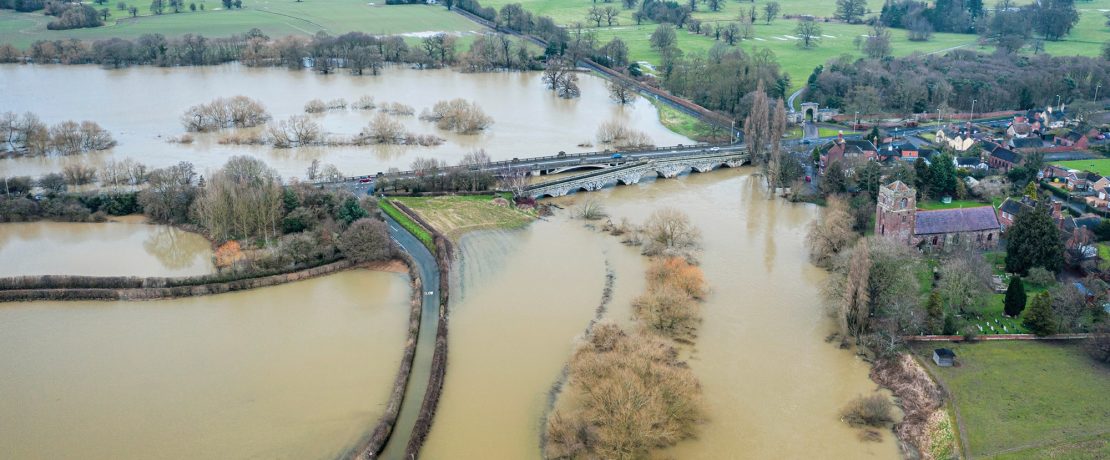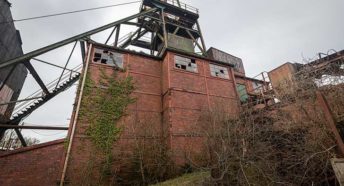Slowing the flow: managing water to reduce flooding
We must take responsibility for water management in England, says Andy Boddington – or the consequences will be ever more severe.
I begin the final draft of this article in the early hours of Sunday 16 February 2020. Storm Dennis is raging outside. Air pressure has fallen so quickly that the weather system is now classified as an ‘explosive cyclogenesis’. A month’s rain has fallen in less than 48 hours.
I can’t take my eyes away from the river gauges displayed on my laptop. Here in south-west Shropshire, the rivers Onny, Corve and Teme are rising towards record levels. Around 5am, my social media feeds start buzzing with talk of streets flooding. At 6am, my phone rings with the first reports of floodwater pouring into houses. I pull on my wellies and high vis and head to the flood zones in the town centre. I feel as helpless as everyone else as one of the most powerful forces in nature wrecks homes and businesses.
By mid-morning, more than forty properties in Ludlow are flooded. I talk to residents. I hear bravado. Resignation. Tears. The flood quickly becomes a tourist spectacle that we don’t need. People stand on bridges and roads gazing in awe as a roaring torrent of brown water erodes river banks. Fells trees. Ruins homes and beautiful dreams as the water rises above kitchen worktops. The flood peaks late afternoon at just 2cm below the highest level recorded in Ludlow. Then the clean up begins.
Our most precious resource
We need water. It’s vital for our basic human needs, managing the world’s environment and for growing our food. But recently we’ve had far too much.
Just as often, we have far too little. Only a few months ago, Sir James Bevan, the chief executive of the Environment Agency warned that England will face water shortages by 2040. We will reach the ‘jaws of death’, he said. ‘Unless we take action to change things, we will not have enough water to supply our needs.’
That’s the dilemma we face in England. As the atmosphere warms with climate change, it can hold more moisture. With more moisture comes more rain. And with more rain comes more flooding. Yet the 30 million people in the southern and eastern regions of our country have faced droughts and restrictions on water use.
This will get worse. The government is insisting that councils plan for 266,000 new homes a year. For some councils, Whitehall’s targets are not enough. One million homes are proposed for the Oxford to Cambridge Arc, all of which will need water. Developers are keen to build energy-efficient homes but water efficiency measures, such as greywater recycling, barely get a look in. Too often driveways are laid with tarmac and paving increasing the risk of flash flooding.
Water, water everywhere?
Faced with a threatening water shortage, engineers are thinking big. But government thinking is far behind.
The government’s water strategy, published in 2011, is now looking dated. It ruled out a national water grid but there are already extensive water transfers, like Lake Vyrnwy and the Elan Valley reservoirs in mid-Wales – built in the Victorian era and supplying Liverpool and Birmingham via aqueducts. Schemes like these will be tougher to deliver in our crowded 21st-century landscape. Even so, Thames Water is talking about a plan to transfer water from the Severn to the Thames from after 2080.
Before then, the water company wants to realise its dream of building a huge reservoir outside Abingdon in Oxfordshire. It first unveiled its plans for the Upper Thames Reservoir in 2006. The idea was to pump water from the Thames in times of plenty and pour it back into the river when water was short. It could then be extracted downstream for London. But the water company couldn’t demonstrate the reservoir was needed and the plans were thrown out. Now the scheme is back and it’s even bigger because Thames has done a deal to sell on water to another South East company, Affinity Water.
The Group Against Reservoir Development (GARD) has been fighting the scheme since its inception, pointing out that the reservoir would not be resilient in the face of a prolonged drought and arguing for more sustainable alternatives. They’re particularly keen that Thames Water prioritises its very poor leakage rate and encourages households to use water much more efficiently. CPRE Oxfordshire director Helen Marshall says that with its 30-metre high walls, the reservoir will be the highest industrial structure in Oxfordshire. It will cover more than 4 square miles of wildlife-rich farmland that acts as the flood plain for Abingdon and surrounding villages, increasing the risk of local flooding – including from the sort of wall breach seen at Whaley Bridge.
Fenlands in the front line
The Fens supply nearly a quarter of our food supply but Alan Jones, chair of CPRE Cambridgeshire and Peterborough, reports that ‘the very wet winter made it difficult to lift root crops or sow this year’s wheat and barley’. Sea levels are rising by 3mm a year in the Wash and the coast is being eroded by North Sea currents. The dilemma is whether to give way to nature or spend billions on building ever bigger flood defences. With a huge loss of fenland farmland by 2100, Alan believes that at the very least, ‘we must put much stronger protection on that ‘best and most versatile’ agricultural land which is on higher ground.’
Elsewhere, boreholes are drawing so much water that chalk streams are running dry even when there is not a drought. The Chilterns Conservation Board fears that High Speed 2 will damage the Chilterns aquifer. Water will be extracted to dissolve chalk into slurry to drive a tunnel under the AONB. There are fears this will reduce the flow of the Misbourne and other chalk streams.
River water also needs cleaning up, and Philip Dunne MP has introduced a private members’ bill to stop water companies dumping untreated sewerage in rivers. Campaigns are underway to get bathing water status for part of the Wharfe in West Yorkshire, London’s Thames, and the Windrush in the Cotswolds.
High risk homes
In the aftermath of February 2020’s Storm Dennis, media reports suggest ministers are considering adopting a new policy which will accept flooding as an inevitable consequence of climate change. The message to homeowners and businesses in the forthcoming National Flood and Coastal Erosion Risk Management Strategy for England will be ‘get used to it’.
This echoes government’s long term reluctance to accept flooding as a national priority. In 2017, it rejected a recommendation from the Environment, Food and Rural Affairs select committee for closer monitoring of developments that are likely to increase flood risk.
Floodplains are water’s second home. Thinktank Bright Blue estimates at least 70,000 homes have been built in Flood Zone 3, the land with the greatest risk of flooding, since 2008. Half are in Greater London where flood defences currently cope, though the Thames Barrier is closing more often. Already there is talk of Thames Barrier 2, which will be needed before the end of the century. Many of the other homes on greenfield floodplains have been met by strong local opposition, including by CPRE. But the pressure to build housing seems to be as forceful as the water that has inundated thousands of homes in recent months. And at least 11,400 new homes are still planned in high risk flood areas.
Natural solutions
The usual answer to our flooding problems is to pour more concrete into the landscape. We can’t keep doing that. Our age is defined by a climate emergency and a biodiversity crisis. If concrete was a country, it would be the third largest carbon dioxide emitter in the world. But concrete is nearly always our first port of call.
The 25km Thames Tideway tunnel is a £4.9bn scheme which aims to prevent overflow from London’s storm water and sewerage systems getting into the River Thames. Estimates suggest construction will emit more CO2 than the capital pumps out from transport in a year. Perhaps that is a price worth paying but Philadelphia has taken a very different approach. Its world-leading Green City, Clean Waters scheme uses green infrastructure to soak up and slowly release water.
Hard engineering with concrete should be a last resort. We need to work with the grain of our landscape, not against it.
Restoration of moorland peat habitats and planting trees can make a major difference at a fraction of the cost of hard engineering. The Birmingham University Institute for Forest Research has demonstrated planting trees upstream can reduce the level of flooding. A study of the River Cherwell in Oxfordshire showed that removing embankments and restoring pre-engineered channels can decrease water flow.
There’s much we can do locally. Across the country, campaigners are running projects to rewild the landscape and ‘slow the flow’. The Pontbren Project in uplands in Wales showed sheep-free plots planted with broadleaved trees were more than sixty times more effective at absorbing surface runoff than grazed grassland. On small streams around the country, leaky dams are being built from felled trees, which are then replaced by new planting.
We live in stormy times. One of the biggest storms coming up is the management of water. We have too much of it. But we don’t have enough when and where we need it. We must use less so we don’t run short. And we must slow the water that falls, taking the opportunity to enhance the countryside in the process.
For far too long water has not gained national attention outside of floods and droughts. It is time to change that. Planners, councils, communities and parliament must make it a national priority.
Andy Boddington is a campaigner for the countryside and a councillor in Shropshire.
A version of this article was originally published in CPRE’s award-winning magazine, Countryside Voices. You’ll have Countryside Voices sent to your door three times a year, as well as access to other benefits including discounts on attraction visits and countryside kit from major high street stores when you join as a CPRE member. Join us now.









